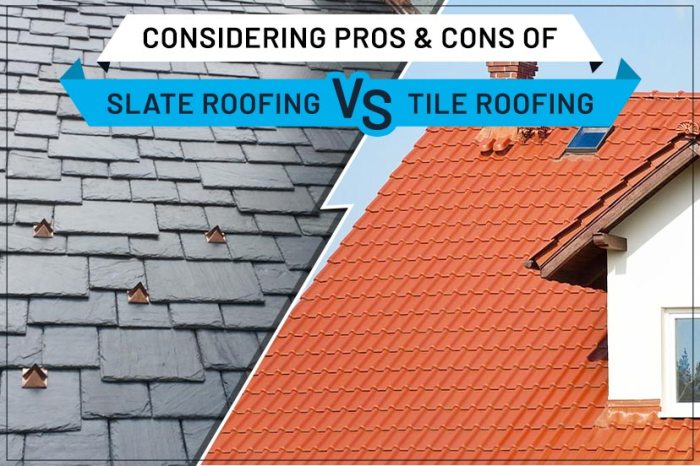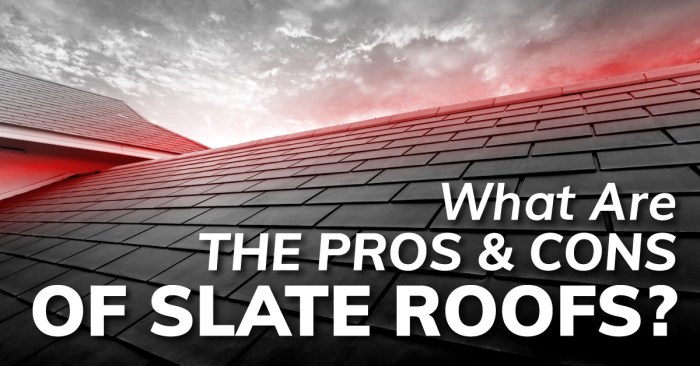Exploring the Pros and Cons of Slate Roofing

Delving into the world of slate roofing pros and cons, this introduction aims to provide a comprehensive overview of this traditional roofing material. From its durability to aesthetic appeal, we will uncover all aspects of slate roofing in this discussion.
As we dive deeper, you will gain insights into the benefits and drawbacks of choosing slate as your roofing option.
Pros of Slate Roofing

Slate roofing offers numerous advantages that make it a popular choice for homeowners looking for a durable and aesthetically pleasing roofing material.
Durability of Slate Roofing
Slate is known for its exceptional durability, with a lifespan that can exceed 100 years when properly maintained. This longevity far surpasses other roofing materials like asphalt shingles, making slate a cost-effective option in the long run.
Enhanced Curb Appeal
Slate roofing adds a touch of elegance and sophistication to any home, enhancing its curb appeal and increasing its overall value. The natural beauty of slate tiles can complement a variety of architectural styles, giving your home a timeless and upscale look.
Eco-Friendly Material
Slate is a natural material that is sourced from quarries, making it a sustainable and eco-friendly roofing option. Unlike synthetic roofing materials, slate is non-toxic and recyclable, reducing its environmental impact and carbon footprint.
Cost-Saving Benefits
While the upfront cost of installing a slate roof may be higher than other roofing materials, the long-term cost-saving benefits are significant. With minimal maintenance requirements and exceptional durability, slate roofing can save homeowners money on repairs and replacements over the years.
Cons of Slate Roofing
When considering slate roofing for your home, it is important to be aware of some drawbacks associated with this material.
Weight-related Issues
Slate roofing is considerably heavier than other roofing materials, which can pose challenges during installation. The structural integrity of your home must be assessed to ensure it can support the weight of the slate tiles.
Higher Upfront Costs
One of the major drawbacks of slate roofing is the higher upfront costs compared to other roofing materials such as asphalt shingles or metal roofing. The initial investment required for slate roofing can be a deterrent for some homeowners.
Difficulty in Finding Skilled Professionals
Installing and maintaining a slate roof requires specialized skills and knowledge. Finding skilled professionals who have experience working with slate can be challenging, leading to potential delays and higher costs for installation and repairs.
Limitations in Color Options
Unlike other roofing materials that offer a wide range of color options, slate roofing is limited in terms of color choices. The natural variations in slate tiles may restrict your ability to achieve a specific aesthetic for your home.
Maintenance Requirements
When it comes to maintaining a slate roof, there are specific tasks and considerations that need to be addressed to ensure its longevity and performance.
Maintenance Tasks for Slate Roofing
- Regular Inspection: It is crucial to inspect the slate roof at least once a year to identify any damaged or missing slates, as well as check for any potential leaks.
- Debris Removal: Clearing debris such as leaves, branches, and dirt from the roof can prevent water pooling and damage to the slates.
- Replacing Damaged Slates: Any cracked or broken slates should be promptly replaced to maintain the integrity of the roof and prevent water infiltration.
- Gutter Maintenance: Keeping the gutters clean and free of debris is essential to ensure proper drainage and prevent water damage to the roof.
Preventing Common Issues
- Trimming Overhanging Branches: Tree branches hanging over the roof can cause damage to the slates and should be trimmed regularly.
- Avoid Walking on the Roof: Excessive foot traffic on a slate roof can lead to cracked or dislodged slates, so it is best to avoid walking on it whenever possible.
- Sealing Flashings: Properly sealing flashings around chimneys, vents, and skylights can prevent water penetration and potential leaks.
Frequency of Inspections and Repairs
Inspections should be done annually, with repairs carried out as soon as issues are identified to prevent further damage. Prompt attention to maintenance needs can prolong the lifespan of a slate roof.
Comparison of Maintenance Costs
While slate roofing may have higher upfront costs, the maintenance costs over the long term are relatively low compared to other roofing materials. The durability of slate and its resistance to weathering and rotting make it a cost-effective choice in the long run.
Longevity and Lifespan

Slate roofing is renowned for its exceptional longevity and lifespan, making it a popular choice for homeowners looking for a durable roofing material that can stand the test of time.
Typical Lifespan of a Slate Roof
Slate roofs are known to last for over 100 years, with some well-maintained roofs lasting even longer. The natural durability of slate makes it a long-lasting roofing option compared to other materials.
Historical Buildings with Slate Roofs
Many historical buildings around the world feature slate roofs that have stood strong for centuries. Examples include the Buckingham Palace in London, St. Patrick's Cathedral in New York City, and the Natural History Museum in Paris, showcasing the longevity of slate roofing.
Value Added to Property
The longevity of slate roofing adds significant value to a property, as it eliminates the need for frequent roof replacements and repairs. This can be a major selling point for homeowners looking to invest in a property with a long-lasting roof.
Comparison with Other Roofing Materials
When compared to common roofing materials like asphalt shingles or metal roofing, slate roofing far surpasses in terms of lifespan. While asphalt shingles typically last 20-30 years and metal roofing around 50 years, slate roofs can last well over a century with proper maintenance.
Conclusion
In conclusion, slate roofing offers a unique blend of durability, eco-friendliness, and timeless elegance, but it also comes with challenges such as weight issues and higher upfront costs. Understanding the nuances of slate roofing can help you make an informed decision for your home.
User Queries
What is the typical lifespan of a slate roof?
A well-maintained slate roof can last anywhere from 75 to 200 years, making it one of the longest-lasting roofing materials available.
Are there limitations on color options for slate roofing?
Yes, slate roofing comes in natural colors like gray, black, green, and red. Custom colors are rare and may require special ordering.
How do maintenance costs of slate roofing compare to other materials?
While slate roofs have higher upfront costs, they require minimal maintenance over their lifespan, making them cost-effective in the long run when compared to other materials.

